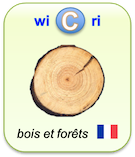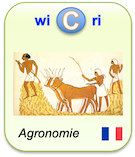Living on the Edges: Spatial Niche Occupation of Asian Citrus Psyllid, Diaphorina citri Kuwayama (Hemiptera: Liviidae), in Citrus Groves.
Identifieur interne : 000156 ( PubMed/Curation ); précédent : 000155; suivant : 000157Living on the Edges: Spatial Niche Occupation of Asian Citrus Psyllid, Diaphorina citri Kuwayama (Hemiptera: Liviidae), in Citrus Groves.
Auteurs : Mamoudou Sétamou [États-Unis] ; David W. Bartels [États-Unis]Source :
- PloS one [ 1932-6203 ] ; 2015.
English descriptors
- KwdEn :
- MESH :
- growth & development : Hemiptera.
- Animal Distribution, Animals, Citrus sinensis, Female, Life Cycle Stages, Spatio-Temporal Analysis, Surveys and Questionnaires.
Abstract
The spatial niche occupation of the Asian citrus psyllid, Diaphorina citri Kuwayama, 1908, was evaluated to determine its field colonization and food resource exploitation strategies in citrus groves. Mature grapefruit and sweet orange groves were surveyed as part of an area-wide program in 2009-2010 to determine D. citri population densities and between-tree distribution. In both cultivars, significantly more psyllids were found on perimeter trees throughout the study period suggesting a strong edge effect in D. citri distribution in the groves. D. citri densities and infestation levels gradually declined from the edge to the center of grove. Higher numbers of D. citri were recorded on trees located on the east and south sides of the groves than those on the west and north sides. Citrus groves located at the outer edge of the study with at least one side non-surrounded to other citrus groves harbored significantly more D. citri than groves located within the block cluster and entirely surrounded by other groves. In detailed field studies during 2012, infestation of D. citri started from border trees in the grove where possibly one generation is completed before inner trees become infested. In addition, psyllid densities decreased significantly with increasing distance from the grove edge. Using the selection index, D citri exhibited a strong niche occupation preference for border trees.
DOI: 10.1371/journal.pone.0131917
PubMed: 26193111
Links toward previous steps (curation, corpus...)
- to stream PubMed, to step Corpus: Pour aller vers cette notice dans l'étape Curation :000156
Links to Exploration step
pubmed:26193111Le document en format XML
<record><TEI><teiHeader><fileDesc><titleStmt><title xml:lang="en">Living on the Edges: Spatial Niche Occupation of Asian Citrus Psyllid, Diaphorina citri Kuwayama (Hemiptera: Liviidae), in Citrus Groves.</title><author><name sortKey="Setamou, Mamoudou" sort="Setamou, Mamoudou" uniqKey="Setamou M" first="Mamoudou" last="Sétamou">Mamoudou Sétamou</name><affiliation wicri:level="1"><nlm:affiliation>Department of Agriculture, Agribusiness and Environmental Sciences, Texas A&M University-Kingsville Citrus Center, Weslaco, Texas, United States of America.</nlm:affiliation><country xml:lang="fr">États-Unis</country><wicri:regionArea>Department of Agriculture, Agribusiness and Environmental Sciences, Texas A&M University-Kingsville Citrus Center, Weslaco, Texas</wicri:regionArea></affiliation></author><author><name sortKey="Bartels, David W" sort="Bartels, David W" uniqKey="Bartels D" first="David W" last="Bartels">David W. Bartels</name><affiliation wicri:level="1"><nlm:affiliation>Center for Plant Health Science Technology, Plant Protection Quarantine-Mission Laboratory USDA-APHIS, Mission, Texas, United States of America.</nlm:affiliation><country xml:lang="fr">États-Unis</country><wicri:regionArea>Center for Plant Health Science Technology, Plant Protection Quarantine-Mission Laboratory USDA-APHIS, Mission, Texas</wicri:regionArea></affiliation></author></titleStmt><publicationStmt><idno type="wicri:source">PubMed</idno><date when="2015">2015</date><idno type="RBID">pubmed:26193111</idno><idno type="pmid">26193111</idno><idno type="doi">10.1371/journal.pone.0131917</idno><idno type="wicri:Area/PubMed/Corpus">000156</idno><idno type="wicri:Area/PubMed/Curation">000156</idno></publicationStmt><sourceDesc><biblStruct><analytic><title xml:lang="en">Living on the Edges: Spatial Niche Occupation of Asian Citrus Psyllid, Diaphorina citri Kuwayama (Hemiptera: Liviidae), in Citrus Groves.</title><author><name sortKey="Setamou, Mamoudou" sort="Setamou, Mamoudou" uniqKey="Setamou M" first="Mamoudou" last="Sétamou">Mamoudou Sétamou</name><affiliation wicri:level="1"><nlm:affiliation>Department of Agriculture, Agribusiness and Environmental Sciences, Texas A&M University-Kingsville Citrus Center, Weslaco, Texas, United States of America.</nlm:affiliation><country xml:lang="fr">États-Unis</country><wicri:regionArea>Department of Agriculture, Agribusiness and Environmental Sciences, Texas A&M University-Kingsville Citrus Center, Weslaco, Texas</wicri:regionArea></affiliation></author><author><name sortKey="Bartels, David W" sort="Bartels, David W" uniqKey="Bartels D" first="David W" last="Bartels">David W. Bartels</name><affiliation wicri:level="1"><nlm:affiliation>Center for Plant Health Science Technology, Plant Protection Quarantine-Mission Laboratory USDA-APHIS, Mission, Texas, United States of America.</nlm:affiliation><country xml:lang="fr">États-Unis</country><wicri:regionArea>Center for Plant Health Science Technology, Plant Protection Quarantine-Mission Laboratory USDA-APHIS, Mission, Texas</wicri:regionArea></affiliation></author></analytic><series><title level="j">PloS one</title><idno type="eISSN">1932-6203</idno><imprint><date when="2015" type="published">2015</date></imprint></series></biblStruct></sourceDesc></fileDesc><profileDesc><textClass><keywords scheme="KwdEn" xml:lang="en"><term>Animal Distribution</term><term>Animals</term><term>Citrus sinensis</term><term>Female</term><term>Hemiptera (growth & development)</term><term>Life Cycle Stages</term><term>Spatio-Temporal Analysis</term><term>Surveys and Questionnaires</term></keywords><keywords scheme="MESH" qualifier="growth & development" xml:lang="en"><term>Hemiptera</term></keywords><keywords scheme="MESH" xml:lang="en"><term>Animal Distribution</term><term>Animals</term><term>Citrus sinensis</term><term>Female</term><term>Life Cycle Stages</term><term>Spatio-Temporal Analysis</term><term>Surveys and Questionnaires</term></keywords></textClass></profileDesc></teiHeader><front><div type="abstract" xml:lang="en">The spatial niche occupation of the Asian citrus psyllid, Diaphorina citri Kuwayama, 1908, was evaluated to determine its field colonization and food resource exploitation strategies in citrus groves. Mature grapefruit and sweet orange groves were surveyed as part of an area-wide program in 2009-2010 to determine D. citri population densities and between-tree distribution. In both cultivars, significantly more psyllids were found on perimeter trees throughout the study period suggesting a strong edge effect in D. citri distribution in the groves. D. citri densities and infestation levels gradually declined from the edge to the center of grove. Higher numbers of D. citri were recorded on trees located on the east and south sides of the groves than those on the west and north sides. Citrus groves located at the outer edge of the study with at least one side non-surrounded to other citrus groves harbored significantly more D. citri than groves located within the block cluster and entirely surrounded by other groves. In detailed field studies during 2012, infestation of D. citri started from border trees in the grove where possibly one generation is completed before inner trees become infested. In addition, psyllid densities decreased significantly with increasing distance from the grove edge. Using the selection index, D citri exhibited a strong niche occupation preference for border trees.</div></front></TEI><pubmed><MedlineCitation Status="MEDLINE" Owner="NLM"><PMID Version="1">26193111</PMID><DateCreated><Year>2015</Year><Month>7</Month><Day>21</Day></DateCreated><DateCompleted><Year>2016</Year><Month>04</Month><Day>15</Day></DateCompleted><DateRevised><Year>2015</Year><Month>7</Month><Day>29</Day></DateRevised><Article PubModel="Electronic-eCollection"><Journal><ISSN IssnType="Electronic">1932-6203</ISSN><JournalIssue CitedMedium="Internet"><Volume>10</Volume><Issue>7</Issue><PubDate><Year>2015</Year></PubDate></JournalIssue><Title>PloS one</Title><ISOAbbreviation>PLoS ONE</ISOAbbreviation></Journal><ArticleTitle>Living on the Edges: Spatial Niche Occupation of Asian Citrus Psyllid, Diaphorina citri Kuwayama (Hemiptera: Liviidae), in Citrus Groves.</ArticleTitle><Pagination><MedlinePgn>e0131917</MedlinePgn></Pagination><ELocationID EIdType="doi" ValidYN="Y">10.1371/journal.pone.0131917</ELocationID><Abstract><AbstractText>The spatial niche occupation of the Asian citrus psyllid, Diaphorina citri Kuwayama, 1908, was evaluated to determine its field colonization and food resource exploitation strategies in citrus groves. Mature grapefruit and sweet orange groves were surveyed as part of an area-wide program in 2009-2010 to determine D. citri population densities and between-tree distribution. In both cultivars, significantly more psyllids were found on perimeter trees throughout the study period suggesting a strong edge effect in D. citri distribution in the groves. D. citri densities and infestation levels gradually declined from the edge to the center of grove. Higher numbers of D. citri were recorded on trees located on the east and south sides of the groves than those on the west and north sides. Citrus groves located at the outer edge of the study with at least one side non-surrounded to other citrus groves harbored significantly more D. citri than groves located within the block cluster and entirely surrounded by other groves. In detailed field studies during 2012, infestation of D. citri started from border trees in the grove where possibly one generation is completed before inner trees become infested. In addition, psyllid densities decreased significantly with increasing distance from the grove edge. Using the selection index, D citri exhibited a strong niche occupation preference for border trees.</AbstractText></Abstract><AuthorList CompleteYN="Y"><Author ValidYN="Y"><LastName>Sétamou</LastName><ForeName>Mamoudou</ForeName><Initials>M</Initials><AffiliationInfo><Affiliation>Department of Agriculture, Agribusiness and Environmental Sciences, Texas A&M University-Kingsville Citrus Center, Weslaco, Texas, United States of America.</Affiliation></AffiliationInfo></Author><Author ValidYN="Y"><LastName>Bartels</LastName><ForeName>David W</ForeName><Initials>DW</Initials><AffiliationInfo><Affiliation>Center for Plant Health Science Technology, Plant Protection Quarantine-Mission Laboratory USDA-APHIS, Mission, Texas, United States of America.</Affiliation></AffiliationInfo></Author></AuthorList><Language>ENG</Language><PublicationTypeList><PublicationType UI="D016428">Journal Article</PublicationType><PublicationType UI="D013485">Research Support, Non-U.S. Gov't</PublicationType></PublicationTypeList><ArticleDate DateType="Electronic"><Year>2015</Year><Month>Jul</Month><Day>20</Day></ArticleDate></Article><MedlineJournalInfo><Country>United States</Country><MedlineTA>PLoS One</MedlineTA><NlmUniqueID>101285081</NlmUniqueID><ISSNLinking>1932-6203</ISSNLinking></MedlineJournalInfo><CitationSubset>IM</CitationSubset><CommentsCorrectionsList><CommentsCorrections RefType="Cites"><RefSource>Conserv Biol. 2013 Jun;27(3):509-19</RefSource><PMID Version="1">23531018</PMID></CommentsCorrections><CommentsCorrections RefType="Cites"><RefSource>Oecologia. 2008 Mar;155(3):549-58</RefSource><PMID Version="1">18157553</PMID></CommentsCorrections><CommentsCorrections RefType="Cites"><RefSource>J Econ Entomol. 2008 Aug;101(4):1478-87</RefSource><PMID Version="1">18767763</PMID></CommentsCorrections><CommentsCorrections RefType="Cites"><RefSource>Annu Rev Entomol. 2013;58:413-32</RefSource><PMID Version="1">23317046</PMID></CommentsCorrections><CommentsCorrections RefType="Cites"><RefSource>Environ Entomol. 2010 Apr;39(2):618-24</RefSource><PMID Version="1">20388295</PMID></CommentsCorrections><CommentsCorrections RefType="Cites"><RefSource>J Insect Sci. 2013;13:36</RefSource><PMID Version="1">23895634</PMID></CommentsCorrections><CommentsCorrections RefType="Cites"><RefSource>J Econ Entomol. 2014 Apr;107(2):691-6</RefSource><PMID Version="1">24772551</PMID></CommentsCorrections><CommentsCorrections RefType="Cites"><RefSource>Environ Entomol. 2009 Aug;38(4):1250-8</RefSource><PMID Version="1">19689907</PMID></CommentsCorrections><CommentsCorrections RefType="Cites"><RefSource>J Insect Sci. 2011;11:83</RefSource><PMID Version="1">21870969</PMID></CommentsCorrections></CommentsCorrectionsList><MeshHeadingList><MeshHeading><DescriptorName UI="D063147" MajorTopicYN="N">Animal Distribution</DescriptorName></MeshHeading><MeshHeading><DescriptorName UI="D000818" MajorTopicYN="N">Animals</DescriptorName></MeshHeading><MeshHeading><DescriptorName UI="D032084" MajorTopicYN="Y">Citrus sinensis</DescriptorName></MeshHeading><MeshHeading><DescriptorName UI="D005260" MajorTopicYN="N">Female</DescriptorName></MeshHeading><MeshHeading><DescriptorName UI="D006430" MajorTopicYN="Y">Hemiptera</DescriptorName><QualifierName UI="Q000254" MajorTopicYN="N">growth & development</QualifierName></MeshHeading><MeshHeading><DescriptorName UI="D008018" MajorTopicYN="N">Life Cycle Stages</DescriptorName></MeshHeading><MeshHeading><DescriptorName UI="D062211" MajorTopicYN="N">Spatio-Temporal Analysis</DescriptorName></MeshHeading><MeshHeading><DescriptorName UI="D011795" MajorTopicYN="N">Surveys and Questionnaires</DescriptorName></MeshHeading></MeshHeadingList><OtherID Source="NLM">PMC4507854</OtherID></MedlineCitation><PubmedData><History><PubMedPubDate PubStatus="received"><Year>2015</Year><Month>3</Month><Day>26</Day></PubMedPubDate><PubMedPubDate PubStatus="accepted"><Year>2015</Year><Month>6</Month><Day>8</Day></PubMedPubDate><PubMedPubDate PubStatus="entrez"><Year>2015</Year><Month>7</Month><Day>21</Day><Hour>6</Hour><Minute>0</Minute></PubMedPubDate><PubMedPubDate PubStatus="pubmed"><Year>2015</Year><Month>7</Month><Day>21</Day><Hour>6</Hour><Minute>0</Minute></PubMedPubDate><PubMedPubDate PubStatus="medline"><Year>2016</Year><Month>4</Month><Day>16</Day><Hour>6</Hour><Minute>0</Minute></PubMedPubDate></History><PublicationStatus>epublish</PublicationStatus><ArticleIdList><ArticleId IdType="pubmed">26193111</ArticleId><ArticleId IdType="doi">10.1371/journal.pone.0131917</ArticleId><ArticleId IdType="pii">PONE-D-15-12830</ArticleId><ArticleId IdType="pmc">PMC4507854</ArticleId></ArticleIdList></PubmedData></pubmed></record>Pour manipuler ce document sous Unix (Dilib)
EXPLOR_STEP=$WICRI_ROOT/Wicri/Bois/explor/OrangerV1/Data/PubMed/Curation
HfdSelect -h $EXPLOR_STEP/biblio.hfd -nk 000156 | SxmlIndent | more
Ou
HfdSelect -h $EXPLOR_AREA/Data/PubMed/Curation/biblio.hfd -nk 000156 | SxmlIndent | more
Pour mettre un lien sur cette page dans le réseau Wicri
{{Explor lien
|wiki= Wicri/Bois
|area= OrangerV1
|flux= PubMed
|étape= Curation
|type= RBID
|clé= pubmed:26193111
|texte= Living on the Edges: Spatial Niche Occupation of Asian Citrus Psyllid, Diaphorina citri Kuwayama (Hemiptera: Liviidae), in Citrus Groves.
}}
Pour générer des pages wiki
HfdIndexSelect -h $EXPLOR_AREA/Data/PubMed/Curation/RBID.i -Sk "pubmed:26193111" \
| HfdSelect -Kh $EXPLOR_AREA/Data/PubMed/Curation/biblio.hfd \
| NlmPubMed2Wicri -a OrangerV1
|
| This area was generated with Dilib version V0.6.25. | |

